3/11

Basho wrote that on his way north to Hiraizumi he mistook the way along a little used and
lonely path and ended up in the busy port of Ishinomaki. Even now the trip seems like a detour
into a strange secluded world. One hour on a local bus from the nearest train station the
journey along the coast road leads us to a hotel perched on a cliff. It is mostly empty, and
despite the beautiful scenery leading up to it, from looking out the window it seemed that I
would not get a clear view of the utamakura that we have chased here,
As if by chance to honour
Our prince's reign of peace
The discovery in the north
Of a mountain blooming
With flowers of gold
Otomo no Yakamochi
The mountain of the poem, Kinkazan, is on a small island a few hundred metres across the
water from the hotel, it looks fairly plain, and the view is obscured by ragged bushes and
treetops. However, before dinner, Tamiko and I try to find a way down to the shoreline, and
down precarious steps and over branches blocking the path we find an empty beach.
Listening to the waves there I feel at peace for the first time since coming to Japan. The
mountain in the last minutes of the sun set glows gold, and then, if that was not beautiful
enough, a thick full orange moon rises suddenly from the clouds over the mountain.
4/11
We have to back track a little to move on to our next stop Hiraizumi site of ancient battles
and a shrine covered in gold. We are lucky to find a place to stay that has a grand view over
the old battlegrounds. Many fires burn across the plain and the sun seems to boil the clouds
in its descent behind the mountains. Here we finally catch up with the elusive Toshihiro; after
checking in I go into town and meet up to have dinner, Tamiko elects to stay in. Instantly
upon seeing him I can see that we are going to get on. He has a slightly impish look and has
already sunk two bottles of beer while waiting for us; despite this he looks totally focused. His
knowledge of the uta of the ancient anthologies is very thorough and he can quote off by
heart every waka or haiku for all the places we have visited. Despite this knowledge he is not
in the slightest bit intimidating; it is almost as if the knowledge is a burden to him, and he has
had to take to the road to refresh his interest. After I have also had a few beers the
conversation begins to cover many things a similar childhood appetite for science fiction,
a present interest in Sherlock Holmes and dislike of TV commercials. I am surprised to find we
have so many seemingly random things in common. We are off to different places tomorrow
but should meet up again further south.
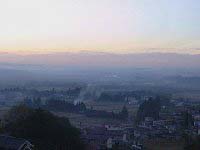
5/11
It is the first day of really bitter cold caused mainly by a strong northern wind. We have
three places to visit: the temple covered in gold, a hill looking over a battlefield and the river
Komoro. The very bright sun makes taking pictures difficult today, the golden temple
Konjikido at Chusonji is in fact protected by a singularly plain-looking concrete outer
building, but even this glows too bright in reflected light. However, after in the plains the
clouds and wind are tremendous.
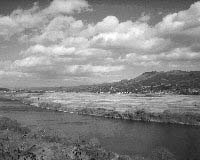
From this viewpoint Basho, thinking of the battles of the Fujiwara clan, wrote that he sat down
and wept
Only the summer grass is left -
The remains of hopes and dreams
Of warriors long dead
The last photo taken tottering over Komorogawa in icy wind finally does me in. When we
get back to our ryokan I have to spend half an hour in the bath to thaw out and I sleep deeply.

When you leave me,
waves of sorrow
from Koromogawa
soak my sleeves
Shinkokinshu #865
8/11
After two days in Sendai trying to find the right kind of film to stock up on we travel on towards
Fukushima and the grave of Lord Sanetaka. It is quite a way from public transport and though
Basho writes of it in Oku No Hosomichi, he failed to reach it. The poem he writes at this point
is of the difficulty of getting to the village nearest the grave
How far is it
To Kasajima village?
Endless road, heavy with mud
Of the early rains
We do manage to get to the grave, by taxi, and while we are there we meet several people
who are also following Basho's Oku No Hosomichi. This particular journey, more than
Saigyo's original journey in Michinoku that Basho wanted to emulate or even Basho's travels
in central Japan, fires something in our imaginationsノ.the idea of self-denial, spiritual
growth through hardship, the rejection of worldly goodsノ.None of this actually applies me
of course, being utterly devoted to my lightweight fully waterproof boots, mobile phone,
laptop and camera equipment. The only rejection of worldly goods I have had to suffer was
a rejection of me by the goods; having failed to pass my driving test before coming to Japan
we have been forced to take public transport.
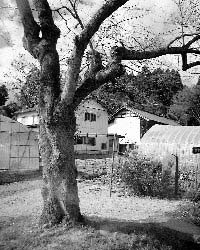
The last site we visit today is the pine tree at Takekuma. Although having been grafted and
re-planted many times over the centuries, even before Basho saw it, the graceful curves and
twin trucks that made the original so renowned have been retained. Unfortunately for me
when we arrive there the strong sunlight makes composing a reasonable picture very difficult.
Tamiko and I have to wait for nearly an hour for some clouds to cover the sun sufficiently so
that the pine is not in shadow, but in the precious few seconds that I am trying to take
a photograph somebody comes up and asks me what I'm doing. While my head is exploding
in fury I try to keep a civil tongue and my face muscles under control. However, the moment
of panic passes; the photograph is taken successfully and I have managed not to be unfairly
rude to anyone. As I pack up my things the man, in English, wishes me good luck.
9/11
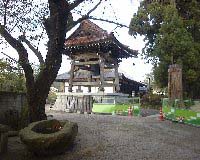
Iouji temple is on a small branch line from Fukushima and Basho wrote of having tea there
and admiring the treasures of the temple a sword of Lord Yoshitsune, who was to later die
at Koromogawa, and a case that belonged to his follower, the warrior-monk Benkei.
On this May day
With banners flying
Proudly show this sword and case
We are too early to enter the temple, but before we go back to Fukushima we walk around the
area and find that behind the temple is a large area of orchards. From the hills around us the
sound of gunfire is so intense that at first I think that we must be in the midst of some self-
defense force exercises, but when I listen more carefully I realise that it is the sound of
hunter's shotguns.
Later in the day we take a bus to Shinobuzuri which from the outside looks unpromising, two
coach loads of obachan arrive as we walk up to the gate, so we decide to wait a while outside.
Initially I am quite disturbed by the fact that at nearly all the main sites we have been to the
atmosphere has been dominated by the loud chattering and laughing of these women who
seem to take no interest in the actual place they are visiting. Then as we are sitting in the sun
outside the temple it occurs to me that we hardly ever see the husbands. I ask Tamiko where
they are 'Dead?' she replies.
When eventually we go into the temple grounds it is empty. Tamiko tells me the story of the
moss-covered stone behind an old rusted gate a young man and woman of the local village
fall in love, but he has to return to the distant capital. For a hundred days she prays at the rock
for his return and on the hundredth day a vision of his face appears in the rock, which she
takes as sign of him coming back. But he does not return; she takes poison, and a letter
from him expressing his constant love comes too late.
Basho wrote very obliquely about the rock which had previously been used for dying cloth,
only relating how local farmers thought it a nuisance because of all the visitors it brought.
The haiku he wrote has the slenderest relation to the story of the romance;
Busy working hands
Of girls planting rice,
Reminding me
Of the old way of dying cloth
Up on a hill above the rock is a pine tree in beautiful autumn colours.

On the way back to Fukushima we come to the Abukuma river whose name means 'to meet
again'. A poem from one of the old anthologies is:
If Abukumagawa
Is not on your way
How then can you contemplate
Leaving me now?
Shinkokinshu #866
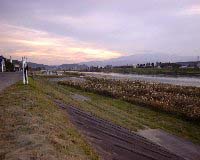
10/11
The day is too bright. We go to a little out of the way utamakura at Asakayama that at first we
cannot find. Tamiko has read that it is a spring, and seeing a sign we suppose that the small
wet ditch below it is the spot. Contemplating my options I set my equipment down nearby and
walk around. In fact the well is a little further on next to a giant pylon and sheltered by a
beautifully shaped pine tree. Apart from this small area directly by the well and the tree,
the place had a very empty feel to it; only car parks and a sandy children's park. Two old men
were attending to the little garden of the well cast suspicious glances at me while I set up the
camera.
Asakayama -
Like the deep mountain well
that reflects even the shadow of things,
I think of you
Not with a shallow heart
Man'yoshu #3807
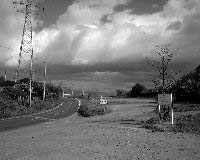
11/11
Although I left the capital together with the spring mist
now the autumn wind is blowing
At Shirakawa gate

I know from my limited knowledge of Japanese literature that Shirakawa has a special
significance as the start of the north. Many songs have been written here of the sorrow
of parting or the feelings of finally leaving the known country of the south. We are of course
travelling in the opposite direction, and, unrealistically of course, I am somehow expecting
to come to a town that will somehow make me feel like I am on the edges of the sophistication
of Tokyo. In fact we have a hard time trying to find anywhere to stay, and while Tamiko tries
to find a hotel I make friends with the station cat who miaows as he comes up to all
the people passing through.
We have no choice about where to stay and the business hotel that we check into feels a
little odd; there is too much pornography lying around and directly outside our window two
workmen are working on digging a grave in a large cemetery. Although I have to wake up
early tomorrow I cannot sleep
12/11
I get a taxi to the old Shirakawa border gate at dawn; smoke from bonfires mixes with early
morning mist. Where the taxi drops me off I am surprised to see how shabby the gate is
considering its prominence in Japanese literature.
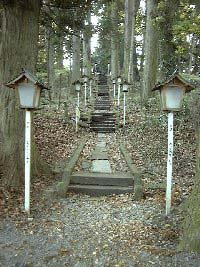
The dilapidated state of the place is very beautiful to me though; leaves lay un-swept all
around, and moss and weeds grow on the roof of an empty shrine. I never enjoy waking up
early in the morning, but the reward today is to see the dawn sun rise through the trees and for
there to be no one to break the silence.
More trains south to Sessho seki the murder stone. The smell of sulphur everywhere, it is
spectacular scenery, but a few metres down from the stones is a strange ghost town of
minshiku and onsen which seem derelict even though there are the odd signs of habitation.

It seems that earlier this year heavy rains caused a great deal of damage to the area and the
tourist trade has suffered accordingly. There is a crisp chill in the air an otherworldly
coldness and clarity. We have an unexpectedly delicious meal in a roadhouse eatery
sitting next to a blind man who is really enjoying his beer.
12/11
Up just before the dawn. It looks bad outside and in fact turns out to be the hardest morning
so far snow driven by a very cold wind. A suitable setting for the murder stone. At first a
gorgeous red dawn makes the autumn trees glow, but as the snow clouds take over my hands
stop responding to commands. Still it is exhilarating being on the mountainside on my own.
Scent of the stone
The summer grass turns red
The morning dew burns hot
Basho

The next stop is Kurobane, the journey looks unpromising a local train to Nishinasuno, then
to get to Unganji no public transport for 14 kilometres. After this morning's work I am chilled
to the marrow and very tired. So tired that a two hour wait as the result of missing a connection
leaves me unruffled since I am barely awake anyway sitting in the middle of nowhere with
a cold sun hurtling down with nothing to do. When we get to Kurobane things look even
more pitiful. The place we are staying has clearly seen it's heyday we are the only guests
in a minshiku that has an empty banqueting hall. The kindness of the owners makes the stay
even more moving. We are given a lift by one of the men of the house to komyoji. This turns
out to be a stone in some bushes with nothing of interest around it at all. I am very
hard pushed to find an interesting shot. But as we walk back to town we are treated to another
wonderful sunset with golden clouds.
I go to sleep directly after dinner and wrap myself up tight to sweat out a cold that's just
around the corner.
13/11
Now we have the task of going to Unganji at 7.00am, which seems like throwing good money
after bad as it's a 4000 yen taxi trip after the sun has come up already. However, as it turns
out there is something very special at Unganji; a temple that is a temple, and not a tourist
attraction. I can feel it as we cross the bridge over the stream to enter the temple grounds. We
have two hours to wait until the first bus back to town, but it is two hours of quiet happiness.
This sacred abode
Amid the summer trees
Not even a woodpecker
Would dare disturb it
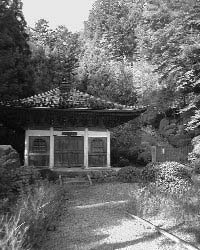
We leave to go on to Nikko. A place that I have wanted to visit for many years, but I have a
feeling of dread as we arrive in the crowds in the late afternoon, without a place to stay. It
feels as if we have really left the north and come back to the outskirts of Tokyo.
14/11
In the morning, up early to take pictures of the main road looking towards mountain
Kurokamiyama and the light coming through the trees.
I am blessed to see
Fresh green leaves
Shining in the sun
Basho Narrow Road To The North

When Tamiko wakes up we walk up to the waterfall Uramitaki; a thin trail through the red
maples to a rainbow glittering in a grove over the splashing water,
A moment of silence in a hollow
Watching the waterfall -
First sight of summer
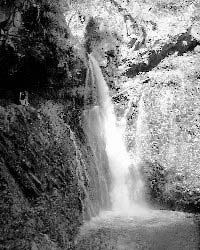
Tamiko and I spend the rest of the day amongst the crowds; watching archers on horseback,
young couples and American tourists. As it gets dark we leave for Tokyo on a crowded slow
train with no reading matter to hand.
|
|
1998年11月3日
朝6時前に雄島へ撮影に。日の出を待って撮影。
たちかへり又もきてみん 松嶋や をじまのとまや波にあらすな
帰って旅館で朝ご飯。まぐろ納豆が美味。旅館のひととても親切。部屋にこたつがあって、おば
あちゃんの家に泊まっているようだ。
この後塩釜に泊まる予定だったが、歌が無いので急遽変更して牡鹿半島へ行くことにする。金華
山を撮るため。塩釜まで電車で行きそこからバスで1時間半、鮎川港に向かう。地元のひとしか
乗らないローカルバスらしく、観光客は見当たらない。茶色に海焼けした頑丈そうな皮膚の、人
目で漁師さんとわかるおじいさんが幾人か乗っている。島に渡る橋を渡るとまもなくカーブの連
続が続く。そしてコバルト色の海が、右に広がって見える。海の色が深い。鯨の漁が盛んだった
というのが肯ける色だ。鮎川港に到着後、国民宿舎コバルト荘のひとが車で迎えにきてくれる。
チェックインしてから散歩がてら撮影にでかける。コバルト荘から遊歩道が続くのり浜へ行くこ
とにして、15分くらい森の中を下る。のり浜は、岩にはさまれた長さ100mほどの小さな入
り江の浜辺だった。薄暗い森をぬけてそれを見たときには、あまりの美しさに思わず笑ってしま
った。左手前方に長く横たわる金華山を除いてあとは海だ。ものすごいコバルト色の海だ。日本
海とは違う、優しく深い果てしがない海だ。夢を見ているみたいな気がする。いや、夢より綺麗
だと思う。
天皇の御代栄えむと東なる陸奥山に黄金花咲く
窓から目線の高さに広がる海と金華山と月を見ながら眠る。
1998年11月4日
再びバスで塩釜まで戻り、小牛田、一ノ関と電車を乗り継ぎ平泉へ到着する。昨日の国民宿舎に
味をしめ、ここでも泊まることにする。サンホテル衣川荘。タクシーで着いてみて驚く。立派な
ホテル風だ。大きな温泉もある。でも、何よりいいのは、衣が原を一望に見渡せる高台からの眺
めだ。あちこちから藁を燃やす煙がもうもうとあがって原の輪郭をぼかしている。霧にけむって
いる風景ともとれるが、やはり思い起こすのは戦場だ。城の天守閣から戦を一望しているような
気がする。黒沢の映画のようだと言い合う。昨日のコバルトの海から、今日は田んぼの海だ。目
を離すのが惜しいほどドラマティックな風景だ。
平泉泊
1998年11月5日
レンタサイクルでまずは中尊寺へ。今日は突然風が冷たい。ここでもてんこもりのおばさんバス
ツアーがいる。今年は紅葉がいまひとつだと言いつつも、仲良く写真に収まっている。紅葉を横
目に通り過ぎ金色堂で撮影。
五月雨を降りのこしてや光堂
あまりに寒いので、休憩所で甘酒を飲みながら待つことにする。Hi-visionTVで繰り返し流れる
金色堂のNHK番組を7度は見ている間に撮影は終わった。螺鈿細工にちょっと詳しくなる。
駅へ戻りおいしいお蕎麦を食べ、高館へサイクリング。そんなに高くも無い丘に上り、北上川と
束稲山を撮影。日が上がって多少暖かくなる。おばあさんが3人とおじいさんが1人、一心不乱
に草刈りをしている。青臭い草の匂い。
夏草や兵どもが夢の跡
田んぼの中を走りぬけ衣川古戦場へ出る。お風呂屋さんの煙突のようなものが立っていて重々し
い字で衣川古戦場と書いてあった。すぐ脇を流れる衣川を撮る。衣川の流れを眺めながらのんび
り待つ。浅いが早い瀬だ。川面をすごい速さで駆け抜けていく風が見えた。
衣川 みなれし人のわかれには たもとまでこそ浪は立ちけれ
平泉泊
1998年11月6日
8時にチェックイン後、タクシーで一首坂へ行く。源義家に追われた阿部貞任が、義家の下の句
に咄嗟に作歌した上の句が義家を感じ入らせたおかげで命拾いしたと言われている場所らしい
。民家裏手の田んぼ横にある石碑を撮る。石碑に陽が当たるのを2時間待つ。なにもないところ
で、仕方ないので本を立ったまま読みながら。飽きるとその辺をぐるぐる歩き回って散歩するが
、飼い犬に不審がられ吠えられ続ける。うるさいので吠え返したら、5倍になって帰ってきた。
年を経し糸の乱れの苦しさに 衣の館はほころびにけり
電車で再び仙台へ戻る。フィルム補給とこのWebsiteの編集のため。
仙台泊
1998年11月7日
午前中はフィルム探し。Johnの使っているKodakの白黒フィルムは、あまり仙台では需要がない
のかどこにも見当たらずやっと駅前の大型電化製品デパートで見つける。40本買う。午後から
はWebsite2回目の編集作業をホテルにおこもりしてがんばる。送ってしまったあとは限りなく
すっきり。多少疲れもたまっていたので、ちょうどよい休養だった。
仙台泊
1998年11月8日
昨日午後ゆっくりしたおかげで今日は元気。さっそく仙台駅から東北本線で名取へ向かいそこか
らタクシーで実方中将のお墓に行く。駅からわりあい離れているし、運転手さんが知っているか
不安だったが、すぐにわかる。今年が実方中将没1000年に当たるそうで、名取市が大々的に宣
伝しているとのこと。きてみると、確かに、「実方朝臣終焉の地 名取」という赤紫色の幟がは
たはたしているし、写真を撮っている間に5人ほど人がやってきた。内のひとりは趣味でおくの
細道をまわっていると言う穏やかそうな男性だった。今回は3泊4日で松島周辺を車でまわって
いるらしい。
朽ちもせぬその名ばかりを留置きて枯れ野の薄形見にぞ見る
笠島はいづこさ月のぬかり道
帰りは田んぼの畦道をひたひた歩いてバス停まで歩く。がんセンター前という名のこの大きな建
物に、お天気の良い日曜の午後、あまりにたくさんの車が入っていった。空が青い。
JRで岩沼へ。武隈の松を撮影。
さくらより松は二木を三月越し
再びJRで福島到着。辺りを見渡して目に付いた駅向かいのホテルに泊まる。
福島泊。
1998年11月9日
福島は都会だと思っていたが、わりとシケている。夜なんかガランとしている。と思ってよく見
ると全体的に古い建物が多いようだ。寂しい感じがいい。
朝、路面電車のような福島交通で医王寺へ。早すぎてまだ開いていないので、お寺のご近所の駄
菓子やを撮影。ゴミだしのおばさんがじっと見ている。その駄菓子やの脇をくねくねと幅車一台
分くらいの道があるので気になって辿ってみる。柿がまるまるとなっている。りんごもある。木
ごと果物をこんなに見たのは久しぶりと思いながらさらに進むと、目の前いっぱいの果樹園が広
がった。魔法のようだ。普通の民家の住宅地から5分と歩いていないし、表からは何も見えない
のだ。ぱあん、ぱあんと花火のような音がしている。猟をしている銃声らしい。
笈も太刀も五月にかざれかみ幟
いったんホテルに戻り休憩してバスで信夫の文知摺観音へ。バスが2時間に1本しかない上にバ
ス停からえらく遠い。迷子になりながらようやく着くと、ちょうど観光バス2台分の人が到着し
たところで、前のお店で自動販売機のお茶を飲んで待つ。外から見るよりずっと大きな観音堂で
、大小の深緑色した沼や赤や黄色に染まった木々が美しい。草刈りの機械を操るおじいさん達の
ほかは誰もいない。奥へ山道を歩いていくといつの間にやら観音堂の裏山に出てしまったらしい
。割合大きな鉄筋の建物があって場所がらラブホテルかと思ったら老人ホームだった。
早苗とる手もとや昔しのぶ摺
バスを2時間待つのが嫌で、帰りは国道沿いに30分ほど歩いて阿武隈川岸で夕日を撮影。予定
していなかったのに、日没ぴったりに間に合う。
行末に阿武隈川のなかりせばいかにかせましけふの別れを
福島泊
1998年11月10日
JRで日和田駅着。安積山へ。
安積香山影さへ見ゆる山の井の浅き心をわが思はなくに
次はまた電車に戻り須賀川へ向かう。駅構内に大きなコミュニティーセンターがあり、大型TV
が待合室に置いてある他、観光案内や荷物預かりまで無料でしてくれる。ショートヘアのきれい
なお姉さんに芭蕉地図をもらい、荷物も預け身軽になって市街へ。
世の人の見付けぬ花や軒の栗
また電車に乗り白河に泊まる。
1998年11月11日
6時前にタクシーで白河の関跡へ向かうJohnを横目にベッドへ戻る。今日はどうしても起きられ
ない。
都をば霞とともにたちしかど秋風ぞ吹く白河の関
チェックアウトの際、ろくでもないビジネスホテルで電話代4000円くらいボラれそうになりか
ろうじて反撃、撃破する。400円のところ10倍もふっかけるなんていくらなんでも図々しくな
いか。花咲じいさんのお隣の欲張りじいさんばあさんのような中年夫婦がやっているホテルだっ
た。ホテル中川。皆さん気をつけましょう。
電車を黒磯駅で降りてバスに乗り換え那須湯元へ。那須高原というので有名らしいが、道沿いに
は「お菓子とお花のファンシードリームランド」だの「夢の3Dメルヘン水族館」だの、あま
りに怪しすぎてその内容を確かめずにはおられなくなりそうなものが軒並み数キロ続いている
。やがて着いた那須湯元温泉はちょっとしなびたいい感じの温泉。殺生石を下見し、温泉街を散
歩する。殺生石から小川に沿って最初のうちは浴衣姿の人もちらほらいて民宿や旅館が営業して
いるが、200mも下ると半分以上空家や廃業した旅館が立ち並ぶ。廃屋の前に緑色の風車が二
つ、からから音を立ててまわっている。寂しい風情があり過ぎて、楽しくなる。つげ義春の貧乏
旅行記のようだ。
野を横に馬ひきむけよほととぎす
夜になると季節外れの温泉街は闇と静寂に包まれる。雪が降り始める。
那須湯元泊
1998年11月12日
目覚めると外は雪景色かと思ったが、積もらない雪らしい。全体的に灰色の雰囲気だが積もって
はいない。また5時半に撮影にでかけるJohnを見送ってしまう。温泉宿のわりにほったらかし
にしておいてくれるここは居心地がいい。どうも留守番のおばさんがあまりやる気がないらしく
、昨日午後に着いたときも「寝過ごしちゃったあ」と目をこすりながら出てきた。のんびりして
いて、とてもいい人だ。
雪の中昨日の温泉街を撮影。町全体はモノクロだが吹き上げる温泉はレモン黄色やうす緑色で、
ペンキをぶちまけたようだ。
バスでまた「ペンション1年1組」や「不思議の国トリックアートファンシー館」等々を横目に
見つつ黒磯へ戻り、電車で西那須野へ。黒羽行きのバスを5分差で逃してしまい2時間バス停で
待つ。2時間も待つと、たとえバスには40分しか乗らなくても果てしなく遠くへ来た様な気が
する。
予約しておいた旅館のおじさんが親切に車で光明寺跡へ連れていってくれる。何もないですよと
恐縮しながら。
夏山に足駄を拝む首途哉
この旅館はかつては割烹旅館だったらしくどっしりした日本建築で、ところどころ凝った作りが
してあるが、今はほとんど宿泊客もないのか私たちの貸し切りだった。しんとした薄暗い夜中の
廊下をくねくね歩いてお手洗いに行くのが肝試し。
黒羽泊
1998年11月13日
7時にタクシーに来てもらい雲厳寺へ向かう。草や田や畦道に一様に霜がおりて朝日に光ってい
る。12kmも黒羽から離れた山里のこのお寺で2時間ほどを過ごす。早朝の寒さを感じさせな
いくらい気分が清々しい。山と森に囲まれた朝の禅寺の静寂。お堂の前でひなたぼっこしながら
じっと目を閉じる。日の光の偉大さを感じる。
無理矢理持たされたMiniDiscを聴く。ClashとNew Orderを1曲づつ。禅寺とパンクは合うかも
。さっきまで静まりかえって静止していたお寺がごおと空に向かって動き始める感じ。お堂の屋
根がぐにゃりと折れ曲がって空を駆け、木々が平行移動しながらシェイクする感じ。違う気持ち
よさに、コーフンする。
啄木鳥も庵はやぶらず夏木立
きた道を後戻りし、西那須野から宇都宮へ、そこから日光線に乗り換えて日光へ。さすがの観光
地。ひとがうようろしている。紅葉目当てらしい。
日光泊
1998年11月14日
バスに乗り裏見の滝入り口で降りる。ここから40分ほど山へ向かって歩く。車が割合多いので
裏道をとると、朽ちた市営住宅のような作りの家々が並ぶ通りにでる。その部分のほかは、当た
り前の住宅地なのだが。石蹴りしながら滝まで歩く。思ったよりずっと立派な滝だ。1本ではな
く、いく筋も大小の水がいろいろな高さから流れ落ちている。絶え間ない水の音。観光の人もい
たが、それよりもカメラマンのほうが数が勝っていた。知る人ぞ知る所なのだろうか。それにし
てもおじちゃん、おじいちゃんが多い。いろんな種類のカメラがあるが、皆大きなズームレンズ
をつけて場所の取り合いをしながら滝を同じ角度から写している。Johnだけ普通のレンズで、
反対方向を撮ったりしている。協調性がない。
暫時は滝に篭るや夏の初
虹のかかった滝を初めて見た。いつも4色くらいしか数えられなくて誰が虹は7色って決めたん
だと訝っていたが、1時間も消えない虹を6色まで数える。
かの有名な東照宮を見物。目が痛くなるくらい絢爛豪華の連続。30分で飽きた。
東武鉄道浅草行きの快速に乗る。1時間半立ちっぱなし。この3週間で、電車で座れなかったの
は、初めてだということに気が付き愕然とする。
浅草泊
|






